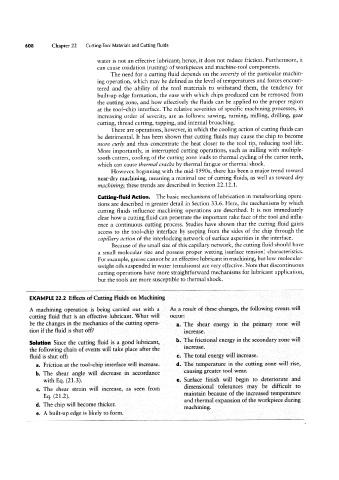Page 627 - 04. Subyek Engineering Materials - Manufacturing, Engineering and Technology SI 6th Edition - Serope Kalpakjian, Stephen Schmid (2009)
P. 627
08 Chapter 22 Cutting-Tool Materials and Cutting Fluids
water is not an effective lubricant; hence, it does not reduce friction. Furthermore, it
can cause oxidation (rusting) of workpieces and machine-tool components.
The need for a cutting fluid depends on the severity of the particular machin-
ing operation, which may be defined as the level of temperatures and forces encoun-
tered and the ability of the tool materials to withstand them, the tendency for
built-up edge formation, the ease with which chips produced can be removed from
the cutting zone, and how effectively the fluids can be applied to the proper region
at the tool-chip interface. The relative severities of specific machining processes, in
increasing order of severity, are as follows: sawing, turning, milling, drilling, gear
cutting, thread cutting, tapping, and internal broaching.
There are operations, however, in which the cooling action of cutting fluids can
be detrimental. It has been shown that cutting fluids may cause the chip to become
more curly and thus concentrate the heat closer to the tool tip, reducing tool life.
More importantly, in interrupted cutting operations, such as milling with multiple-
tooth cutters, cooling of the cutting zone leads to thermal cycling of the cutter teeth,
which can cause thermal crac/as by thermal fatigue or thermal shock.
However, beginning with the mid-1990s, there has been a major trend toward
near-dry machining, meaning a minimal use of cutting fluids, as well as toward dry
machining; these trends are described in Section 22.12.1.
Cutting-fluid Action. The basic mechanisms of lubrication in metalworking opera-
tions are described in greater detail in Section 33.6. Here, the mechanisms by which
cutting fluids influence machining operations are described. It is not immediately
clear how a cutting fluid can penetrate the important rake face of the tool and influ-
ence a continuous cutting process. Studies have shown that the cutting fluid gains
access to the tool-chip interface by seeping from the sides of the chip through the
capillary action of the interlocking network of surface asperities in the interface.
Because of the small size of this capillary network, the cutting fluid should have
a small molecular size and possess proper wetting (surface tension) characteristics.
For example, grease cannot be an effective lubricant in machining, but low-molecular-
weight oils suspended in water (emulsions) are very effective. Note that discontinuous
cutting operations have more straightforward mechanisms for lubricant application,
but the tools are more susceptible to thermal shock.
EXAMPLE 22.2 Effects of Cutting Fluids on Machining
A machining operation is being carried out with a As a result of these changes, the following events will
cutting fluid that is an effective lubricant. What will occur:
be the changes in the mechanics of the cutting opera- a_ The Shear energy in the primary Zone will
tion if the fluid is shut off? increase.
The frictional energy in the secondary zone will
Solution Since the cutting fluid is a good lubricant,
the following chain of events will take place after the increase.
fluid is shut off: The total energy will increase.
a. Friction at the tool-chip interface will increase. The temperature in the cutting zone will rise,
b. The shear angle will decrease in accordance causing greater tool wear.
with Eq. (213), Surface finish will begin to deteriorate and
c. The shear strain will increase, as seen from dimensional tolerances may be difficult to
Eq. (21.2). maintain because of the increased temperature
and thermal expansion of the workpiece during
d. The chip will become thicker.
machining.
e. A built-up edge is likely to form.

